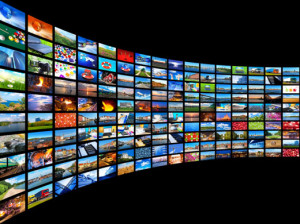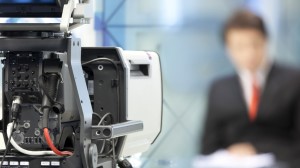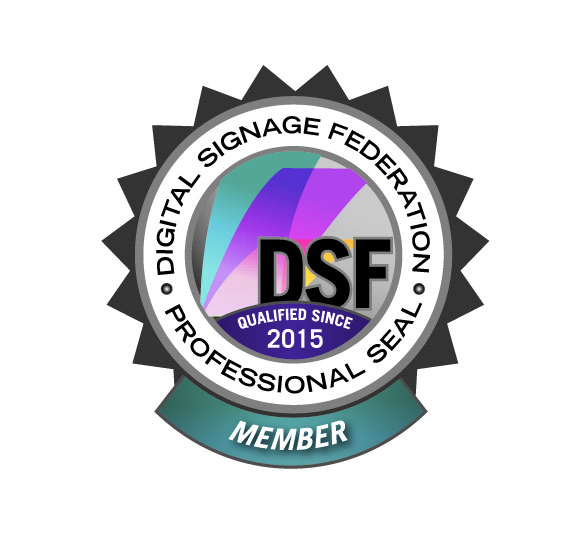Data Call Technologies is the most comprehensive aggregator of infotainment content for rebroadcast in the Americas. From Billboards, Corporate Communication, and Public Access to Numerous Digital Signage networks and screens in the Automotive, Banking, Hospitality, and Retail environments…Data Call provides Dynamic News, Sports, Weather and a whole lot more.
Digital signage is a form of electronic display that shows television programming, menus, information, advertising and other messages.
Digital signs (frequently utilizing technologies such as LCD, LED, plasma displays, or projected images to display content) can be found in both public and private environments, including retail stores, hotels, restaurants, and corporate buildings, amongst other locations.
 Digital signage displays are most commonly controlled by personal computers or servers, through the use of either proprietary software or free software; this approach often allows the operator to avoid large capital outlays for the controller equipment.
Digital signage displays are most commonly controlled by personal computers or servers, through the use of either proprietary software or free software; this approach often allows the operator to avoid large capital outlays for the controller equipment.
Advertising using digital signage is a form of out-of-home advertising in which video content, advertisements, and/or messages may be displayed on digital signs with a common goal of delivering targeted messages, to specific locations and/or consumers, at specific times. This is often called "digital out of home" or abbreviated as DOOH.
Since digital signage content may be both frequently and easily updated, saving the printing and/or construction costs associated with static signage, and also because of the interactive abilities available through the accompanying employment of such real-world interfaces as embedded touch screens, movement detection and image capture devices, it has won wide acceptance in the marketplace.
As LCD and LED displays continue to replace printed marketing materials, the appeal of instantly updating product videos and promotional messages on one or a thousand remotely located displays has driven the adoption of Digital Signage (DS).
While the term "digital signage" has taken hold throughout most of the world, some companies and organizations prefer to use the terms "narrowcasting", "screen media", "place-based media", "digital merchandising", "digital media networks", "digital out-of-home" or "captive audience networks". Whatever the term, DS presentations are typically comprised of repeating loops of information used to brand, market or sell the owner’s products and services. But once viewed, this information becomes repetitive and the viewer typically tunes it out, resulting in low retention of the client’s message. Digital Signage has since become “dynamic” with fresh, relevant, updated content.
 Data Call Technologies has been in this industry since early 2002. About ten years ago, a company wanting to take the digital signage plunge was faced with a myriad of hardware and software companies, all offering their own “vision” of what digital signage should have been. They were given the tools of digital signage, but were left to their own devices as to what to build. Those companies that took the early plunge where then faced with the fact that no one had come before them to show the rights and wrongs, the dos and don’ts of content development. But, even at this early stage of the game, Data Call recognized that these pioneers of digital signage lacked a key component that would become an integral part of any successful implementation -Active Content.
Data Call Technologies has been in this industry since early 2002. About ten years ago, a company wanting to take the digital signage plunge was faced with a myriad of hardware and software companies, all offering their own “vision” of what digital signage should have been. They were given the tools of digital signage, but were left to their own devices as to what to build. Those companies that took the early plunge where then faced with the fact that no one had come before them to show the rights and wrongs, the dos and don’ts of content development. But, even at this early stage of the game, Data Call recognized that these pioneers of digital signage lacked a key component that would become an integral part of any successful implementation -Active Content.
In the years since those early days of digital signage, the market has taken care of shaking out the weaker providers of hardware and software. Companies now have a clearer understanding of what digital signage is, what is needed for a successful implementation and the best use of content space given their more-defined and attainable goals. In the past few years, as the cost of platforms, supporting infrastructure and displays have fallen dramatically; digital signage has become more accessible to a wider range of companies while the growing Kiosk market has cross-pollinated with Digital Signage. And those combined companies are realizing that the initial, one-time cost of getting into the game is far outweighed by the cost of staying in the game, in the form of ongoing content development. As the cost of deployment decreased, companies began focusing on attention-grabbing content. Whether the goal of the presentation was product branding, marketing or assisted selling, content became king. Active content is on everyone’s “needs” list because it is proven to draw customers to the core message and keep customers engaged throughout the presentation. Data Call has always stood ready to serve this ever growing market with its active content.
 Active content is that part of a digital signage presentation that is constantly updated with timely and relevant information. For instance, a typical presentation may contain ten 15-second loops that provide the primary message of the presentation, but the active dynamic content, such as that provided by Data Call, is updated with new information throughout the day. Those seeking to add active and dynamic content to their digital signage presentations are advised to employ Data Call’s integrated content rather than shoehorning broadcast content into their digital signage presentation. By integrating Data Call’s active content alongside their presentations, companies can provide the entertainment content so necessary in dwell-time retention without disrupting the core message of the presentation. Information categories provided by Data Call include news, weather, sports, financial data complete with images coinciding with headlines, Doppler radar, as well as Traffic Flow Maps. With such a broad range of offerings, companies have access to the active and dynamic content they need, regardless of the market they are addressing.
Active content is that part of a digital signage presentation that is constantly updated with timely and relevant information. For instance, a typical presentation may contain ten 15-second loops that provide the primary message of the presentation, but the active dynamic content, such as that provided by Data Call, is updated with new information throughout the day. Those seeking to add active and dynamic content to their digital signage presentations are advised to employ Data Call’s integrated content rather than shoehorning broadcast content into their digital signage presentation. By integrating Data Call’s active content alongside their presentations, companies can provide the entertainment content so necessary in dwell-time retention without disrupting the core message of the presentation. Information categories provided by Data Call include news, weather, sports, financial data complete with images coinciding with headlines, Doppler radar, as well as Traffic Flow Maps. With such a broad range of offerings, companies have access to the active and dynamic content they need, regardless of the market they are addressing.
Over the years, Data Call has worked with the industry leaders in digital signage to develop the data formats and communication methods to allow Data Call’s active content to be easily integrated into their hardware and software products.
Data Call’s approach to customer relations is to not accumulate customers, but to build partnerships. Each Data Call partner is as unique as the digital signage market they service, and each has their own requirements for active content.
In developing active content for digital signage, Data Call identified three factors that had to be addressed - reliability, objectivity and ease of implementation.
To address the reliability requirement, Data Call opted to license information only from the leaders that create news, weather, sports and financial data rather than “scraping” information from the Internet (which can be illegal in most cases) or simply pulling internet RSS feeds (which may have unpredictable lack of consistencies).
By licensing data from these major providers we also satisfied the second requirement, objectivity. The Internet is as littered of slanted opinions and hidden agendas as there are users of the Internet, So arbitrarily allowing these “news” sources to go unchecked into Data Call’s active content was completely unacceptable.
Finally, the third requirement, ease of implementation, was address by both Data Call’s licensing of data and the method by which it was disseminated to their partners.
 Data Call still understands that digital signage and Kiosk implementers have larger issues to tackle than the multitude of licenses that would need to be managed and the varying formats of the source data to be dealt with if active content was obtained from multiple vendors. Data Call offers a “one stop shop” for all of the active content requirements covered by a single license. Ease of implementation also would require that the multiple formats of all Data Call’s data providers be distilled into a single format. Because active content may be displayed in a multitude of ways (banners, tickers, scrolls or artistically integrated with the overall presentation), Data Call originally produced a set of common data layouts in the industry-standard XML (extensible markup language) and RSS (Really Simple Syndication) formats. In 2013 Data Call began offering MRSS or Media RSS which is an RSS extension that allows the transport of media files. Many partners find these formats to be easily integrated into their products, but in several cases, Data Call has produced customized data formats to the exact requirements of their partners. This customization ensures the highest level of reliable and ease of integration possible.
Data Call still understands that digital signage and Kiosk implementers have larger issues to tackle than the multitude of licenses that would need to be managed and the varying formats of the source data to be dealt with if active content was obtained from multiple vendors. Data Call offers a “one stop shop” for all of the active content requirements covered by a single license. Ease of implementation also would require that the multiple formats of all Data Call’s data providers be distilled into a single format. Because active content may be displayed in a multitude of ways (banners, tickers, scrolls or artistically integrated with the overall presentation), Data Call originally produced a set of common data layouts in the industry-standard XML (extensible markup language) and RSS (Really Simple Syndication) formats. In 2013 Data Call began offering MRSS or Media RSS which is an RSS extension that allows the transport of media files. Many partners find these formats to be easily integrated into their products, but in several cases, Data Call has produced customized data formats to the exact requirements of their partners. This customization ensures the highest level of reliable and ease of integration possible.
Market demand, opportunity and technology converge at a single point in time, and Data Call has always been there. Digital signage platforms are evolving to meet mass market requirements, costs for hardware and software are falling to the point of becoming commodities and the markets for digital signage are clarifying through historical trial and error.



